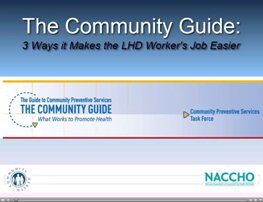
Step 1
CONSULT YOUR CHA/CHIP

Step 2
WRITE A PROBLEM STATEMENT

Step 3
WRITE SMART GOALS AND OBJECTIVES

Step 4
REVIEW AND SELECT STRATEGIES

Step 5
PLAN TO ADAPT AND IMPLEMENT THE STRATEGY

Step 6
IMPLEMENT AND EVALUATE THE STRATEGY
LEARN HOW THE COMMUNITY GUIDE CAN MAKE THE LHD WORKER’S JOB EASIER
View NACCHO’s Screencast Series
THE
COMMUNITY
GUIDE &
THE RESOURCE
CENTER
This site is part of a suite of resources that belong to NACCHO's Resource Center for Evidence-Based Prevention and Cross Sector Approaches.

Click to visit the
Resource Center
Step 2:
Write a Problem Statement
Once you’ve consulted your Community Health Assessment and Improvement Plan, write a problem statement that summarizes your community’s primary public health concerns and prevention priorities. The problem statement can be used in later program planning stages to help you select appropriate evidence-based intervention strategies.
To begin setting priorities, determine which factors most affect your community’s vision for health, the immediacy of identified issues, and identify a manageable number of issues to address. You can also arrange identified issues in order of importance to further prioritize them. Once you’ve determined your priorities, you should summarize them in a problem statement.
Effective problem statements paint a clear picture of the primary health concerns in your community in clear and concise language. It should also include a description of the community’s long-term vision, the health problem to be addressed, the target population affected, socioecological determinants compounding the issue, key stakeholders involved, the historical context of the health problem, and opportunities/priorities for prevention.
You can use the following questions to guide the development of your problem statement:
- What is the health problem?
- Who is affected?
- What are the risk factors?
- What social, individual, policy, environmental, or other factors are involved?
- How do the issues impact the community’s long-term vision?
- What are the prevention opportunities?
- Who are the potential stakeholders?
To download a sample problem statement, visit http://cg.naccho.org and click the resources tab.
Links to Helpful Tools
- Download a Sample Problem Statement
Learn More - Visit NACCHO’s MAPP Site to Learn How to Prioritize Prevention Efforts
Learn More
